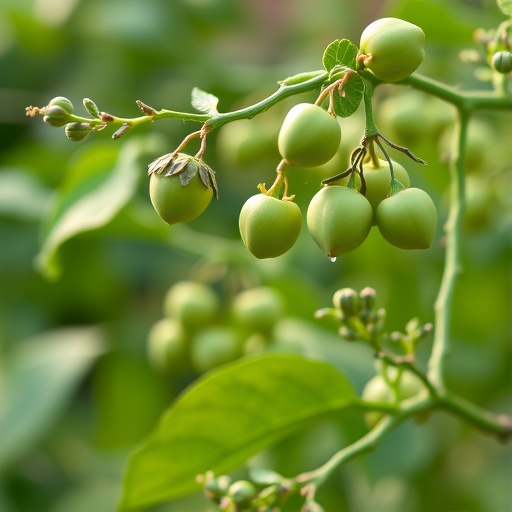A groundbreaking study has unveiled profound insights into the genetic architecture of the classic pea traits originally dissected by Gregor Mendel, reshaping our understanding of inheritance and genetic variation. Despite enduring debates surrounding Mendel’s original intentions and the rigor of his data, this comprehensive genomic analysis emphatically confirms that the traits Mendel studied are governed by distinct genetic loci exhibiting diverse and complex mutational mechanisms. The research underscores the power of modern genomics combined with traditional genetics in resolving century-old biological questions.
Researchers have identified a remarkable variety of mutational events in the genes underlying Mendel’s seven pairs of contrasting traits. These range from point mutations causing single nucleotide changes that disrupt gene function, to transposon insertions—mobile genetic elements—that alter genomic landscapes in previously unappreciated ways. For example, the gene associated with the recessive “a” trait exhibits multiple mutations, including those that affect mRNA splicing patterns and insertions causing frameshifts. In contrast, the “le” trait arises from a missense mutation altering a critical amino acid, highlighting the diverse molecular strategies by which phenotypic variation arises.
Of particular note is the discovery of intragenic suppressor mutations, an unexpectedly sophisticated category of genetic change. One such mutation entails a rare shift in intron position within a gene, a phenomenon scarcely documented even in interspecies gene comparisons. This finding suggests that some alleles have persisted long enough within natural populations to accumulate second-site mutations that suppress or modify the original phenotypic effect, revealing a deeper layer of genetic complexity than previously acknowledged in classic Mendelian traits.
The functional diversity of the genes involved is equally striking. They encompass enzymes controlling key catalytic reactions in primary metabolism, regulators of hormone interconversion, transcription factors guiding secondary metabolic pathways, and structural components influencing cell wall properties. The genes also include small signaling peptides that modulate cell fate and receptor kinases embedded in membranes, providing a rich tapestry of biological processes that collectively shape Mendel’s phenotypes. Intriguingly, the green-versus-yellow coloration in pea cotyledons and pods corresponds, respectively, to disruptions in chlorophyll synthesis and degradation pathways, explaining dominance relationships in these traits.
Delving into the genetic basis of these traits using Genome-Wide Association Studies (GWAS) revealed a striking finding: the Mendelian traits are not controlled by rare alleles with minor effects, as previously speculated, but often correspond to single major loci with substantial influence. While complex traits like fasciation showed evidence of additional modifier loci, most traits produced GWAS peaks that neatly colocalized with known genes, reaffirming the classical Mendelian model in a modern genomic framework.
However, the study did not shy away from the nuances and exceptions. Some traits, such as cotyledon color, exhibited multiple GWAS signals with varying statistical strengths, suggesting that environmental factors or developmental processes influence phenotypic penetrance. Moreover, some broad and diffuse GWAS peaks challenge researchers to refine their mapping strategies further. These complexities underscore both the promise and the limitations of GWAS, even in relatively straightforward genetic models like Pisum sativum.
Central to resolving these challenges has been the combination of GWAS with complementary genetic and genomic approaches. The researchers emphasize that GWAS peak intervals alone often contain multiple candidate genes, necessitating secondary strategies such as induced mutagenesis, bi-parental crosses, transcriptomic comparisons, and functional genetic validation. These methods facilitate the precise identification and characterization of causal genes, enabling deeper mechanistic insights into mutation effects at both the biochemical and cellular levels.
The study also highlights the immense potential of emerging technologies to push the boundaries of pea genetics. Long-read DNA and RNA sequencing promise to capture previously hidden structural variations and complex alleles shaped by transposons and large deletions. Meanwhile, developing efficient gene transformation and editing tools in pea will provide direct ways to manipulate and validate candidate genes, a crucial step for functional genomics and crop improvement.
Utilizing a globally diverse panel of Pisum accessions, the researchers constructed a rich genomic and phenotypic variation map that represents a new frontier for trait dissection in this historically pivotal species. This resource not only advances fundamental biology and education but also lays the groundwork for practical applications in legume breeding. The ability to project findings from pea onto other legume crops could accelerate breeding programs targeting yield, stress resistance, and nutritional quality.
Together, the study reaffirms the relevance of Mendel’s classical work in the age of genomics, demonstrating that the traits he discovered are underpinned by intricate and multifaceted genetic architectures. It bridges legendary genetics with cutting-edge science, offering a template for understanding complex trait inheritance that extends well beyond the humble pea.
As the field moves forward, this integrative genotype-to-phenotype strategy will catalyze new discoveries, providing a roadmap for leveraging natural genetic diversity to unravel crop biology. With ongoing technological advances and expanding genomic resources, the era of systematic molecular trait dissection in pea—and legumes more broadly—has truly begun, promising transformative impacts on biology and agriculture alike.
Subject of Research:
Genomic and genetic analysis of Mendel’s seven classical pea traits, focusing on the diverse mutational mechanisms underlying phenotypic variation and the application of GWAS to link genetic loci to classical traits.
Article Title:
Genomic and genetic insights into Mendel’s pea genes.
Article References:
Feng, C., Chen, B., Hofer, J. et al. Genomic and genetic insights into Mendel’s pea genes. Nature (2025). https://doi.org/10.1038/s41586-025-08891-6
Image Credits: AI Generated




